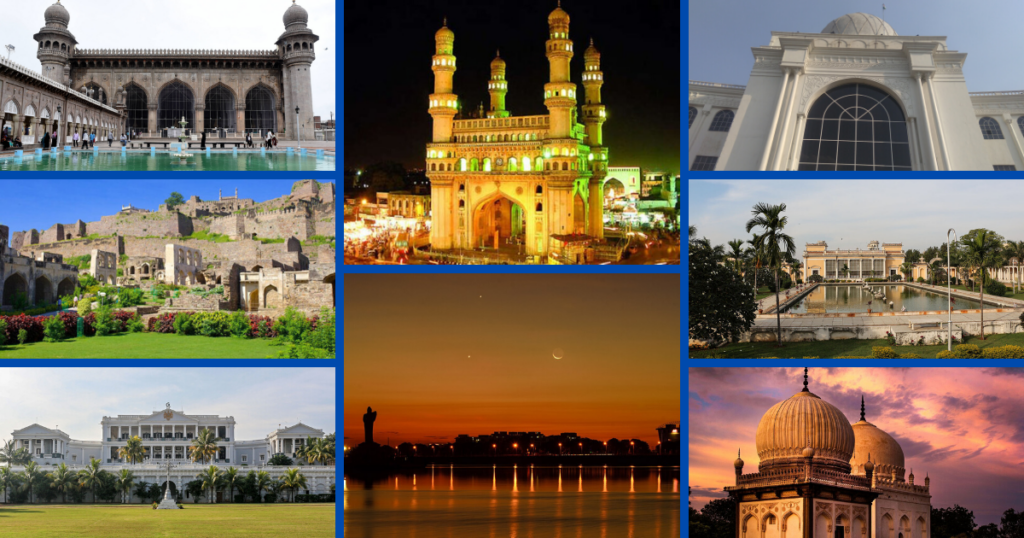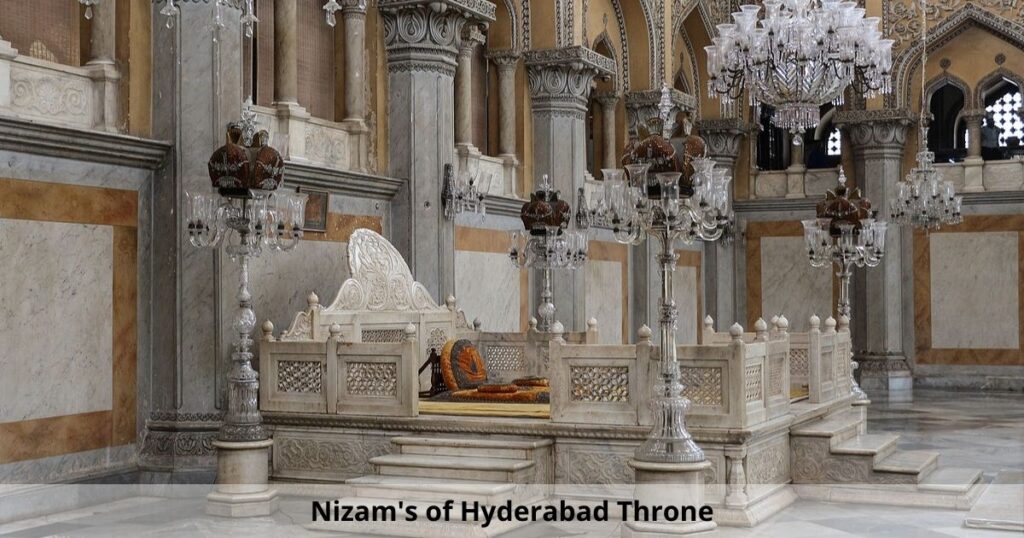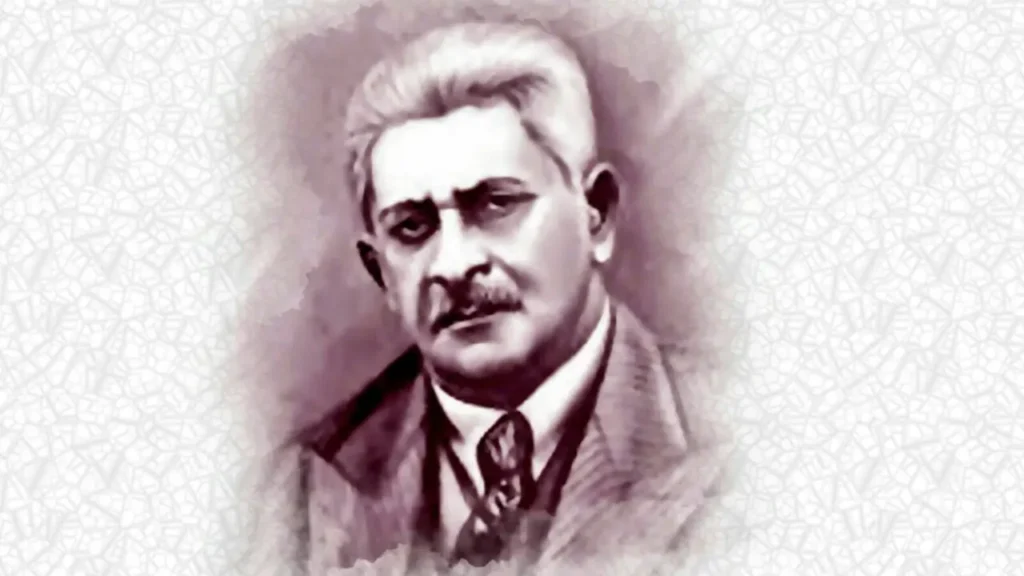The Nizams were the 18th-through-20th-century rulers of Hyderabad. Nizam of Hyderabad (Niẓām ul-Mulk, also known as Asaf Jah) was the title of the monarch of the Hyderabad State (as of 2019 divided between the state of Telangana, Hyderabad-Karnataka region of Karnataka and the Marathwada region of Maharashtra). Nizam, shortened from Nizam-ul-Mulk, meaning Administrator of the Realm, was the title inherited by Asaf Jah I. He was the viceroy of the Great Mughal in the Deccan, the premier courtier in Mughal India in 1724, and the founding “Nizam of Hyderabad”.
The Asaf Jahi dynasty was founded by Mir Qamar-ud-Din Siddiqi (Asaf Jah I), who served as a viceroy of the Deccan under the Mughal Empire from 1713 to 1721. He intermittently governed the region after Emperor Aurangzeb’s death in 1707. In 1724 Mughal control weakened, and Asaf Jah became virtually independent of the Mughal Empire; Hyderabad would then become a tributary of the Maratha Empire, losing a series of battles through the 18th century.
When the British achieved paramountcy over India, they allowed the Nizams to continue to rule their princely states as client kings. The Nizams retained internal power over Hyderabad State until 17 September 1948, when Hyderabad was integrated into the new Indian Union. The Asaf Jah dynasty had only seven rulers; however there was a period of 13 unstable years after the rule of the first Nizam when three of his sons (Nasir Jung, Muzafar Jung and Salabath Jung) ruled. They were never officially recognised as rulers. The seventh and last Nizam, Mir Osman Ali Khan, fell from power when India annexed Hyderabad in 1948.
By the time of its annexation, Hyderabad was the largest and most prosperous one among all the princely states. It covered 82,698 square miles (214,190 km2) of fairly homogeneous territory and had a population of roughly 16.34 million people (as per the 1941 census), of which a majority (85%) was Hindu. Hyderabad State had its own army, airline, telecommunication system, railway network, postal system, currency and radio broadcasting service. Hindus were also given highest of the government posts; like 2-time Prime Minister of Hyderabad – Maharaja Sir Kishen Pershad and Maharaja Chandu Lal. Also given was the position of Kotwal, given to Raja Bahadur Venkatarama Reddy.
A Wealthy State
During the period of the Nizams’ rule, Hyderabad became extremely wealthy – thanks to the Golconda mines which were the ‘only sources of diamonds in the world market at that time (apart from South African mines) making the 7th Nizam the richest person in the world. Osman Ali Khan, Asaf Jah VII and his family including Salar Jung I were taught by Nawab Sarwar Ul Mulk and Agha Mirza Baig Bahadur, who was his political advisor, and the senior-most salute state among the Indian princely states. It was spread over 223,000 km2 (86,000 sq mi) in the Deccan, ruled by the Asaf Jahi dynasty. The Nizams were conferred with the title of His Exalted Highness, and “Faithful Ally of the British Government” by the imperial-colonial British government for their collaborating role in the wars against Tipu Sultan of Mysore, the First War of Indian Independence of 1857–1858, becoming the only Indian prince to be given both these titles.
One example of the wealth of the Nizams are the Jewels of the Nizams, an international tourist attraction once displayed in Salar Jung Museum, but now locked in an Reserve Bank of India vault in Delhi. In 1948 Hyderabad state had an estimated population of 17 million (1.7 crore), and it generated an estimated annual revenue of £90,029,000.
The state had its own currency known as the Hyderabadi rupee, until 1951. The pace at which the last Nizam Mir Osman Ali Khan amassed wealth made him one of the world’s richest men in 1937, also known for his miserliness. He was estimated to be worth ₹660 crores (roughly US$2 billion by the then exchange rates). According to the Forbes All-Time Wealthiest List of 2008, Nizam Mir Osman Ali Khan is the fifth richest man in recorded history per the figures, with an estimated worth of US$210.8 billion adjusted by Forbes as per the growth of the US GDP since that period and the present exchange rate of the US dollar against the Indian rupee.
Hyderabad Institutions
The Nizams set up numerous institutions in the name of the dynasty including hospitals, schools, colleges, and universities that imparted education in Urdu. Inspired by the Indian Civil Service, the Nizams established their own local Hyderabad Civil Service.
Hyderabad Infrastructure
The Nizams commissioned engineering projects such as large reservoirs like Osman Sagar and Himayat Sagar. Survey work on the Nagarjuna Sagar Dam was also initiated during this time, although the actual work was actually completed under the aegis of the Government of India in 1969.
They also gave Hyderabad its own Railway Network -the Nizam’s Guaranteed State Railway which helped in setting up various industries.
Other landmarks include the Telangana High Court, City College, Public Gardens, (formerly Bagh-e-Aaam) Jubilee Hall, Asafia Library, The Assembly building, Niloufer Hospital, the Osmania University, Osmania Arts College, and the Osmania Medical College.
(Source, Wikipedia)
Know More About Hyderabad…
Daily Quote
More Hyderabad News
Telangana News…
Andhra Pradesh News …
More National, Global News
You can get instant news and articles from Hyderabad Post
Click to Like/Follow/Subscribe us on Facebook – Twitter – Telegram – Instagram – WhatsApp – YouTube
























